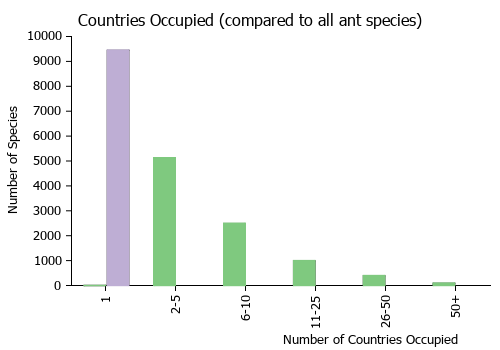Pheidole subaberrans
| Pheidole subaberrans | |
|---|---|
| Scientific classification | |
| Kingdom: | Animalia |
| Phylum: | Arthropoda |
| Class: | Insecta |
| Order: | Hymenoptera |
| Family: | Formicidae |
| Subfamily: | Myrmicinae |
| Tribe: | Attini |
| Genus: | Pheidole |
| Species: | P. subaberrans |
| Binomial name | |
| Pheidole subaberrans (Kusnezov, 1952) | |
Nothing is known about the biology of subaberrans.
Identification
See the description in the nomenclature section.
Keys including this Species
Distribution
Recorded from Tucumán and Salta, Argentina. (Wilson 2003)
Latitudinal Distribution Pattern
Latitudinal Range: -26.808285° to -26.808285°.
| North Temperate |
North Subtropical |
Tropical | South Subtropical |
South Temperate |
- Source: AntMaps
Distribution based on Regional Taxon Lists
Neotropical Region: Argentina (type locality).
Distribution based on AntMaps
Distribution based on AntWeb specimens
Check data from AntWeb
Countries Occupied
| Number of countries occupied by this species based on AntWiki Regional Taxon Lists. In general, fewer countries occupied indicates a narrower range, while more countries indicates a more widespread species. |

|
Estimated Abundance
| Relative abundance based on number of AntMaps records per species (this species within the purple bar). Fewer records (to the left) indicates a less abundant/encountered species while more records (to the right) indicates more abundant/encountered species. |

|
Biology
Castes
Nomenclature
The following information is derived from Barry Bolton's Online Catalogue of the Ants of the World.
- subaberrans. Elasmopheidole subaberrans Kusnezov, 1952b: 71 (s.w.) ARGENTINA. Combination in Pheidole (Elasmopheidole): Kempf, 1972a: 184. See also: Wilson, 2003: 140.
Unless otherwise noted the text for the remainder of this section is reported from the publication that includes the original description.
Description
From Wilson (2003): A member of the aberrans group — actually, an intermediate in habitus between the aberrans and tristis groups — distinguished as follows.
Major: large; head bicolored; occipital carina not present as in other aberrans-group species; hypostoma lacking spines; in full-face view, frontal lobes broad, asymmetrical, with pointed anterior borders that just reach the anterior clypeal border; humeri very large, rising 4X higher than the mesonotal convexity in dorsal-oblique view; acute, forward-projecting process on postpetiolar venter, as seen from the side; pronotum partly covered by transverse carinulae.
Minor: low process present on venter of postpetiole, as seen from the side; semicircular carinulae cover the pronotum; propodeal spines thin, needle-like.
MEASUREMENTS (mm) Lectotype major: HW 1.44, HL 1.76, SL 0.60, EL 0.16, PW 0.86. Paralectotype minor: HW 0.64, HL 0.68, SL 0.54, EL 0.12, PW 0.44.
COLOR Major: reddish yellow except for frontal lobes and borders of mandibles, which are a sharply contrasting blackish brown.
Figure. Upper: lectotype, major. Lower: paralectotype, minor.Scale bars = 1 mm.
Type Material
Argentina. Fundacion e Instituto Miguel Lillo and Museum of Comparative Zoology - as reported in Wilson (2003)
Etymology
L subaberrans, below, i.e., almost aberrans. (Wilson 2003)
References
- Kempf, W. W. 1972b. Catálogo abreviado das formigas da regia~o Neotropical. Stud. Entomol. 15: 3-344 (page 184, Combination in Pheidole (Elasmopheidole))
- Kusnezov, N. 1952d [1951]. El género Pheidole en la Argentina (Hymenoptera, Formicidae). Acta Zool. Lilloana 12: 5-88 (page 71, soldier, worker described)
- Wilson, E. O. 2003. Pheidole in the New World: A dominant, hyperdiverse ant genus. Harvard University Press, Cambridge, MA. (page 140, fig. major, minor described)
References based on Global Ant Biodiversity Informatics
- Kempf, W.W. 1972. Catalago abreviado das formigas da regiao Neotropical (Hym. Formicidae) Studia Entomologica 15(1-4).
- Kusnezov N. 1952. El género Pheidole en la Argentina (Hymenoptera, Formicidae). Acta Zoologica Lilloana 12: 5-88.
- Kusnezov, N. "Lista de las hormigas de Tucumán con descripción de dos nuevos géneros (Hymenoptera, Formicidae)." Acta Zoologica Lilloana 13 (1953): 327-339.
